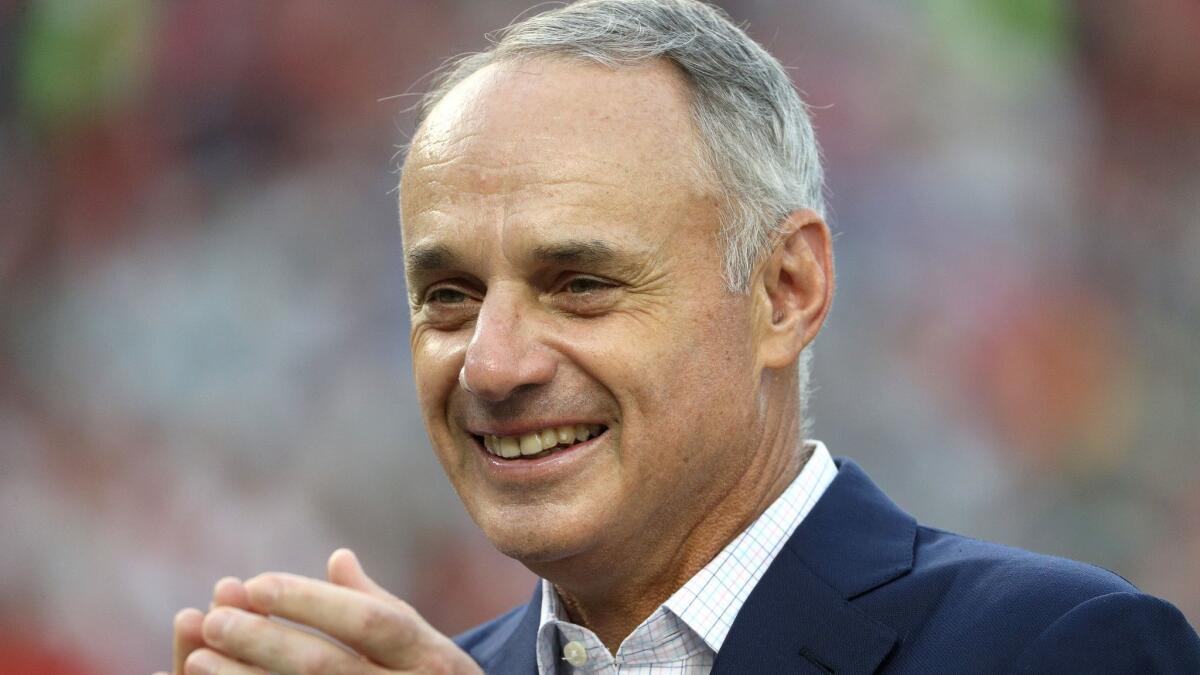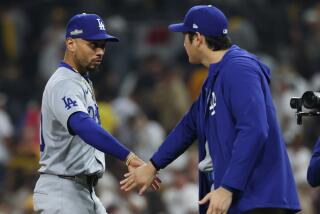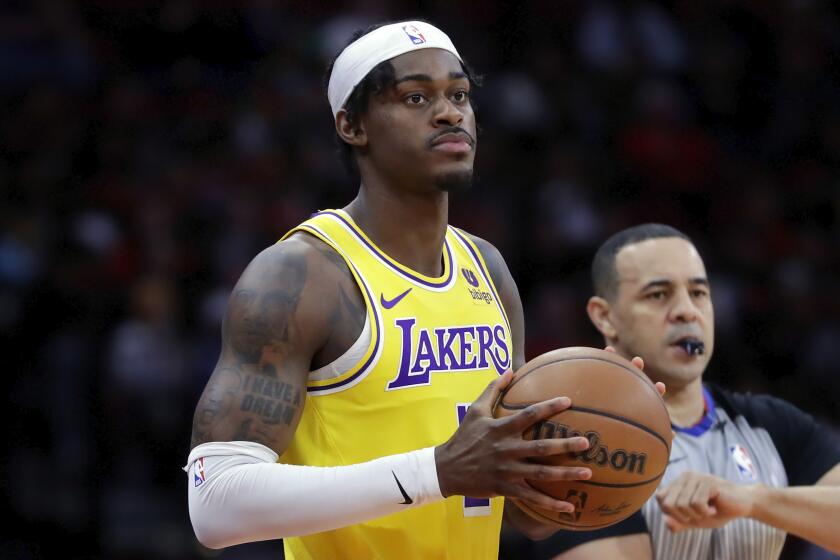Rob Manfred Q&A: Baseball commissioner discusses tanking, attendance decline and 2020 All-Star game at Dodger Stadium

- Share via
The Boston Red Sox are one of the marquee attractions in the major leagues, with a passionate fan base that extends far beyond New England. For the folks charged with marketing and televising baseball, it is a good thing that the Red Sox made the playoffs.
For the guy charged with running the major leagues, it probably is a better thing that the Oakland Athletics made the playoffs.
The Red Sox opened the season with the highest payroll in the majors. The A’s opened the season with the lowest, and they were one of four times cited in a grievance filed last February by the Major League Baseball Players Assn. The teams that make the most money share millions with their less fortunate brethren and, according to the collective bargaining agreement, each beneficiary must direct those millions toward “an effort to improve its performance on the field.”
After a severe chill had hit the free-agent market, the union wondered what evidence might exist to show that the A’s, Miami Marlins, Pittsburgh Pirates and Tampa Bay Rays were living up to that agreement. The Pirates, for instance, had not signed even one free agent to a major league contract.
The A’s won 97 games, more than any team in the National League. The Rays won 90. The Pirates posted a winning record. The Marlins were awful, but they were not one of the three teams that lost 100 games.
The grievance remains unresolved. However, of the teams that opened the season among the top 10 in payroll, more teams missed the playoffs than made them, and two – the San Francisco Giants and Toronto Blue Jays – appear poised to cut back on spending and join the wave of teams that turn to young players and scale back competitive ambitions for a year or two.
That seemed like a good place for Bill Shaikin, the Times’ national baseball writer, to start a conversation with commissioner Rob Manfred. This transcript is lightly edited, with Times clarifications in italic.
Q: There was a lot of talk over the winter about tanking, whether you want to use that term or not. The season has played out. For the first time in 16 years, three teams lost 100 games. Three teams won 100. Do you believe there are reforms you need to propose to incentivize winning?
A: First of all, I think the vast majority of the conversation about – I’ll use your word – tanking was driven by people who either had an agenda, or who don’t understand the fundamental trends that have emerged in the game in terms of the way you put rosters together and how you maintain your competitiveness over time. I think of the four clubs that attracted the most commentary over the winter. One is going to the playoffs. Two were in the hunt well into August. It just goes to show that predictions as to who is going to win, in this changing environment, have not turned out to be that good.
I am not concerned that there is a lack of a desire to win. I am absolutely convinced all of the organizations in Major League Baseball want to win. It is a question of what strategy they have adopted, and what time frame they are looking at, in order to put themselves in a realistic position to win.
Q: Are these the four clubs against whom the Major League Baseball Players Assn. filed a grievance?
A: Yes.
Q: You said some people might not understand what is going on in the game and some have an agenda. What do you mean by an agenda?
A: The MLBPA filed a grievance. They clearly have an agenda. And, by not understanding, what I’m saying is this: If you look at productivity broken down by age in our industry, it has moved down, significantly, the last 10 years. Younger people are providing more of the gross productivity in the industry. When you appreciate that fundamental fact, it is not surprising that people would be interested in getting younger players on the field, to take advantage of that higher productivity.
Q: Attendance this season fell to its lowest level since 2003. Do you believe teams playing not to win in a given year – even if it is a competitive strategy – plays into that attendance decline?
A: There are going to be teams that are in the hunt and teams that are not in the hunt every single year. I think the net effect on attendance depends on whether it’s big markets that are in the hunt or smaller markets that are in the hunt. So I don’t see wins and losses as a huge driving factor.
Q: So how do you explain the 4% drop in attendance this season?
A: I think what happened to us this year is pretty straightforward. We know that a point, a point and a half, of that is related to the fact that Miami is reporting its attendance more accurately, which I applaud. Telling the truth is always a good thing. Secondly, we were down almost 10% in April. We had record cancellations. You never get the same attendance for a rescheduled game. But, even worse, we played 35 games in April where it was less than 40 degrees at game time. We played two last year. I think these factors explain a lot of the downturn.
Having said that, it’s important to remember we’re still drawing nearly 70 million people a year. It’s an astounding number, in and if itself. And all live entertainment – not just sports – faces a challenge in terms of getting people to come, because there are so many more alternatives that are available to people. The younger generation is a little different in terms of what it wants to see. We need to work hard to make sure we’re putting the best entertainment product we can on the field.
Q: From day one of your tenure, you have talked about broadening the sport’s appeal to youth and getting more kids playing baseball. What has been successful on that score, and what do you still need to do to attract a younger audience?
A: I think the PLAY initiative has been tremendously successful for us. [The initiative includes a series of programs and reached over 750,000 children last year, according to the league.]
Over the last three years, we are the fastest-growing sport in terms of youth participation. That includes lacrosse, soccer, hockey, all the sports people talk about. [Baseball gained 1.7 million new participants from 2011-16, the most of any team sport, according to the Sports and Fitness Industry Assn.]
We are still the No. 1 participation sport among young people under the age of 12. That’s a great base to work from. We’re going to continue to work in that space. [That combines baseball and softball, according to the SFIA. That is a fair representation, the SFIA said, because participation totals for sports like basketball and soccer include boys and girls.]
And we’ve made some great strides in terms of diversity. The No. 2 participation sport among African-Americans is now baseball. And you’re seeing that in our draft, where 20% of our first-rounders over the last six years were African Americans. That’s a great number for us. [In its most recent data, the SFIA said, the baseball participation rate among African Americans was higher than the football participation rate.]
Q: You mentioned that people concerned about tanking might not understand how the game has changed in terms of valuing younger players. Since there have been so many skirmishes on that front over the last several years – alleged service time manipulation to delay a player’s arbitration and free agency, the effect of qualifying offers on a player’s free agency, the chill in last winter’s free-agent market, the devaluation of saves, and now the use of “openers” that could devalue starting pitchers – why continue to deal with these issues individually? Wouldn’t it make sense, given how the game has changed in regard to analytics, to sit down with the union and consider building a new player compensation system from scratch?
A: Collective bargaining agreements have terms. Usually what happens is, a trend develops during the term of an agreement that one party or the other has an issue with, and it gets addressed the next time around. I think our clubs, in general, are comfortable operating within the collective bargaining agreement we have now.
But, because I am a labor relations person at heart, I have gone to [union executive director] Tony Clark, and I have told him that I am prepared to sit down and talk about whatever you have on your agenda, at whatever point in time you are prepared to sit down and have those conversations. I’ve told him that does not mean I’m necessarily prepared to alter the terms of the current agreement. But, when you’re talking about an agenda like you laid out there, starting early and having the conversations tomorrow is not necessarily a bad thing. And I have made that offer to Tony.
Q: The underlying issue is that the current system is set up where, if you can work your way through the minor leagues, and through three years in the major leagues without recourse to salary arbitration, and three more years in the majors under arbitration, then free agency is your chance to strike it rich. If that path is going to change, should the compensation system change accordingly?
A: The union has been wedded to the seniority-based compensation system that we have since the day I arrived in baseball in 1987. At various times over that history, we have suggested various alternative economic frameworks, some that were designed to compress payrolls in terms of having a minimum and a maximum. We made proposals in 1990 that were explicitly designed to link pay and performance more closely. They have wanted the seniority-based system. Over time, we have adjusted, and learned to live with it.
If in fact they want to do something different, it really is incumbent upon them to come forward and tell us what it is that they are thinking about. That is why I made the invitation to Tony that I did.
Q: When we talk how to make baseball more popular, we always hear this from fans: I’d just like to be able to watch the game I want to see, wherever I live, if I pay for television or streaming. Baseball’s blackout rules prevent fans from seeing games. Can you foresee a day when fans that want to pay to see a game will not be turned away because of where they live, and what has to happen to get there?
A: First, and most important, we want to make our games as available to fans as we possibly can. We want them everywhere. Number two, we have made great strides in that regard, with products like mlb.tv and [the] At Bat [app] that make games available on all platforms. That’s why we did the Facebook experiment. Some people liked it. Some people didn’t. But it is an example of us trying to find every conceivable platform we can to make games available.
The blackout rules are a really important aspect of our economic system, and of the local television rights of each individual club. A lot of the clubs have granted rights to regional sports networks, in contracts that give those RSNs exclusive control over the local broadcast territory. Those contracts serve as a limitation on our ability to deal with the blackout issue. It doesn’t mean that we’re not going to continue to try to make games more available, but we do need to make those games available against the backdrop of the contractual commitments that have been made by the clubs. It’s really that simple.
[The league encourages RSNs to make streaming available to network subscribers within local broadcast territories. The Dodgers’ SportsNet LA broadcasts are not available in the Los Angeles market because Spectrum has chosen not to stream them, not because of an MLB blackout rule.]
Q: When you became commissioner, I asked if the best available markets for expansion might be outside the United States and you said, “I think that is probably right.” Now that you have played additional exhibition games in Montreal and regular-season games in Mexico, what have you learned that might make you more or less confident in that assessment?
A: I think the results of our play in Montreal during the exhibitions, and in Mexico for exhibitions and the regular season games, confirm the fact that, outside the United States and close enough to the United States are markets that are very interested in having major league baseball. That level of interest, I think, is a huge positive for the sport. That remains a viable alternative for us to explore once we get past the stadium issues in Tampa and Oakland.
Q: Speaking of Oakland: In California, we generally do not publicly finance stadiums any more. The A’s are interested in securing their financing by developing the land around the Oakland Coliseum and using the revenue to build a new ballpark, either on that site or at the Howard Terminal waterfront site. The Angels would have financed an Angel Stadium renovation by developing some of the land around the stadium, at no cost to the city of Anaheim, but the city rejected the idea because the land would not be sold to the Angels at fair market value. Do you believe this is a reasonable way to solve the stadium financing dilemma in California?
A: Major league baseball stadiums have been tremendous drivers of development. It started in Baltimore. It continued through Coors Field in Denver, and the best example recently is what has gone on and continues to go on in Washington, in an area that the city had tried to develop for years.
Our stadiums are civic assets. I know economists argue about football stadiums and basketball arenas, but with 81 home dates, I think the evidence is pretty clear that baseball stadiums drive development. We understand that the availability of governmental financing is much more limited today. I do believe that one way clubs that can make up that gap in what has traditionally been available, in terms of funding, is with development opportunities.
I think the SunTrust development in Atlanta is a great example of a development around a ballpark that is supportive of the massive investment that has to be made in order to build a state-of-the-art baseball facility.
I want to be clear about the Oakland situation. The A’s made a $137-million offer to buy the Coliseum site. They’re not looking for free land. [That is the value of the city and county debt on the complex, not an appraised land value.]
Q: Many economists would say, at least in a downtown area, development is going to happen one way or the other. Why should a city subsidize a ballpark?
A: I think, if you look at the areas around stadiums, “one way or the other” is a bad bet. In the cities I just mentioned, development was just not ongoing. Maybe someday, in 2050, it would have happened. I think it’s really hard to argue with the fact that those stadiums certainly moved the development process along.
Q: What does it mean for the league that Billie Jean King now is part of the Dodgers’ ownership group?
A: From day one, Mark Walter, Todd [Boehly] and Peter [Guber] -- the principal owners -- have been intent on having diversity in their ownership group. I think this is another step along that road. In terms of the institution of major league baseball, it is a huge positive. To have someone who is a legend in another sport as part of an ownership group in baseball, there is nothing but positive about that.
Q: For years, even before you became commissioner, the Dodgers have talked about wanting to bring the All-Star Game back to Dodger Stadium for the first time since 1980. What made the pitch successful this time, when you awarded the 2020 game to the Dodgers?
A: L.A. is a very big city. There’s a lot going on. It is more challenging in a city like that to get the facilities and the hotels lined up in a way that works for an All-Star Game, because there are so many alternative things going on. They were proactive in terms of getting those facilities lined up for us. They overcame some hurdles that I thought might delay or impede getting the game there by working closely with the mayor, who was tremendously supportive. They just made a great bid.
Look, for us, being in L.A. is a tremendous opportunity to market the game. There’s the crossover with all the entertainment groups that are there, all the stars. I am really looking forward to a great event in 2020.
Twitter: @BillShaikin
Follow Bill Shaikin on Twitter @BillShaikin
More to Read
Go beyond the scoreboard
Get the latest on L.A.'s teams in the daily Sports Report newsletter.
You may occasionally receive promotional content from the Los Angeles Times.










